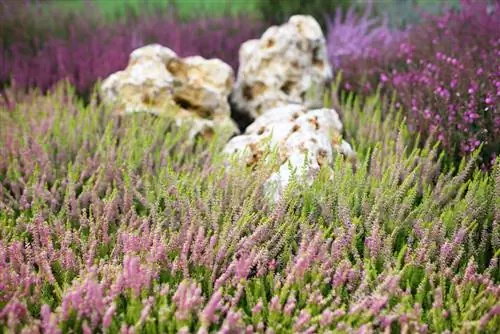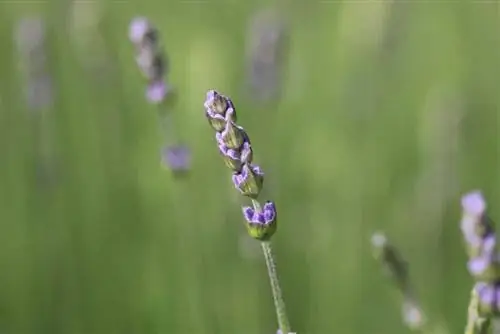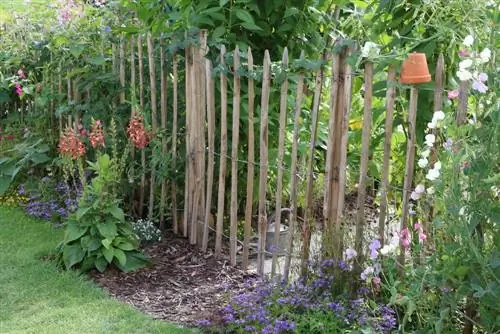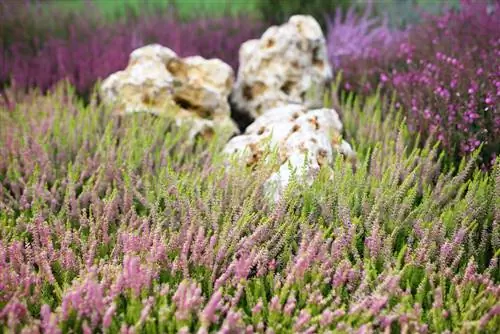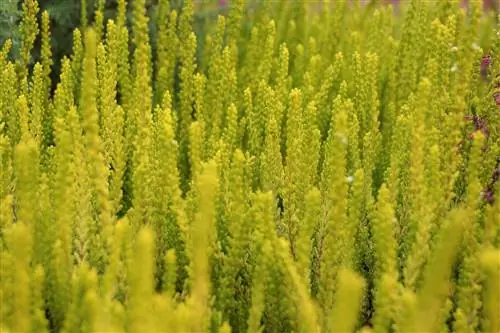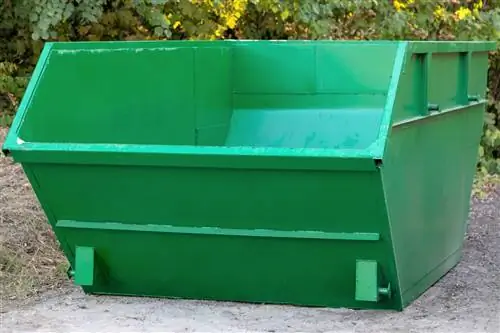- Author admin [email protected].
- Public 2023-12-17 03:39.
- Last modified 2025-01-24 12:45.
A heather garden impresses with its seemingly simple, almost sparse vegetation. Over time, however, the viewer discovers a we alth of different plants that give this garden a constantly new character. This type of garden can be easily achieved with a planting plan that coordinates all of the accompanying plants. Our overview explains which species can turn your front garden into its very own heath landscape.
Typical companion plants in the heather garden
As the main vegetation, heathland landscapes are usually dominated by two plant genera: Calluna and Erica. Both genera have countless species and shapes, so that this core vegetation creates enormous diversity. But it is the accompanying plants that actually make this form of vegetation what it is. There is a much larger range of different genera to choose from for your planting plan:
Dwarf coniferous trees
The dwarf forms of native conifers are particularly suitable for your own heath landscape in the front garden. Due to their comparatively large dimensions despite their dwarf form, these types of garden design add a third dimension. On the other hand, the low, stocky core characteristics of the heather are not significantly changed by the growth forms, which remain low, but are merely supplemented and loosened up in an interesting way.
Juniper (Juniperus communis)
- Growth height up to a maximum of 3 meters, dwarf forms usually significantly lower
- Growth habit low crouched, or columnar upright
- Strong, clearly pronounced thorns
- Inconspicuous yellow flowers, later deep dark blue to red berries
- High light requirement, therefore often found in low-growing heathland without any other trees
- Considered undemanding, therefore suitable for poor limestone and sandy soils
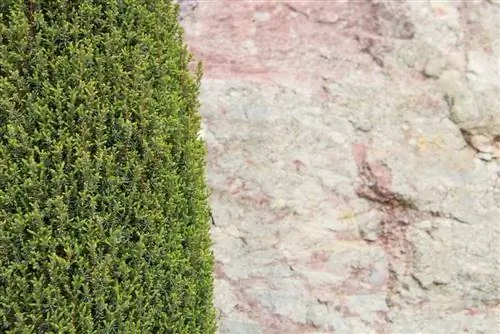
NOTE:
In the typical poetry of the Romantic period, juniper, a typical growth of the central and northern German juniper heaths, is repeatedly found as a central element of the atmospheric framework. Popular topics include, for example, the shepherd who, close to nature and in harmony with the seasons, leads his flock through the constantly changing juniper heath.
Pines (Pinus)
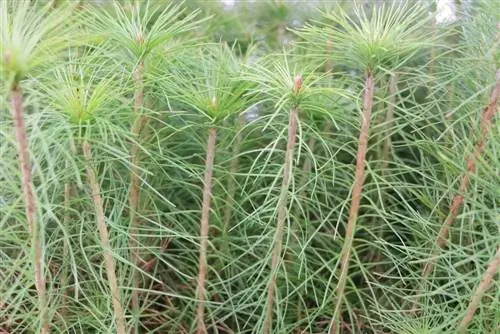
- e.g. as dwarf pine, shrub pine or mountain pine
- long needles on all sides of the shoot
- umbell-like, rather inconspicuous yellow-green (male) or red (female) inflorescences
- Usually squat, bushy growth habit when growing low
- very high resin content, therefore often with a typical, intense resin smell
- considered undemanding, therefore easy to combine with typical heather soils
- Easily adjustable in shape and size by cutting
Spruce (Picea)
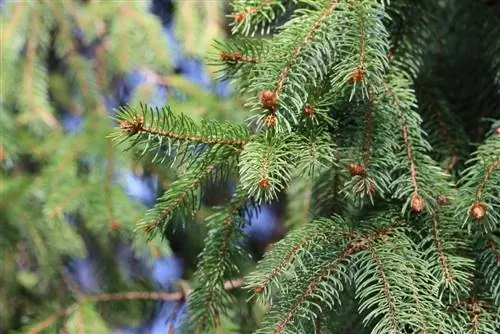
- evergreen
- characteristic flaky, reddish-brown bark
- shrub-like growth only in the right location: open, windy, little protection, barren, sandy soils with low nutrient content
- short, opposite needles with bushy shoot ends
- Cones individually or in pairs on the shoot tips
- Inconspicuous, yellowish flower
- Typical conifer scent due to high resin content in wood, bark and shoots
Hemlock(Tsuga)
- as a cushion hemlock, often flat, not very growing
- short, protruding needles arranged on all sides
- very inconspicuous greenish flowers
- tiny cones, usually less than 1 centimeter
- good possibilities for shaping, but required to a much lesser extent than, for example, with pine trees
NOTE:
The hemlock is not a typical accessory plant that occurs in natural heathland landscapes. However, due to its properties and in particular its low growth habit, it is a good companion plant in your own heathland design. It is therefore representative of various types of coniferous trees that have been bred to grow slowly and remain small specifically for the limited space available in home gardens.
Shrubs
In addition to coniferous trees that remain small or are deliberately kept small, various types of shrubs can also visually enrich your heath landscape with a little fullness and height. In contrast to most conifers, shrubs are also able to enrich the floral splendor with additional, clearly recognizable facets.
Gorse (Genista)
- Growth habit from bushy compact to upright and lush
- Growth heights between 0.5 and 2.0 meters, in individual cases even beyond that
- dense, clinging leaves, vaguely reminiscent of typical needle growth
- Intense yellow flower color, with small flower size, but high number of flowers at the end of the shoots
- depending on the species with reinforced shoots
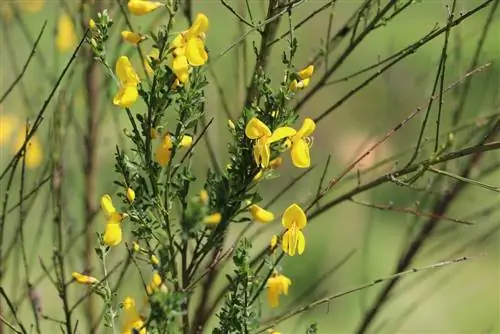
ATTENTION:
All parts of the gorse plant are considered poisonous, so heather plantings, especially in gardens with children or pets, should only use the gorse with appropriate caution.
Crowberry (Empetrum)
- evergreen dwarf shrub with a height of 15 to 60 centimeters
- needle-shaped leaves with a dense base
- Inflorescences: one to a maximum of three small, inconspicuous flowers
- Available as a variant with black (G. negrum) or red (G. rubrum) berries
- Berries can be eaten, other parts of the plant contain andromedotoxin - slightly poisonous
- Very dominant appearance, partially displacing other heather plants
TIP:
If you want to use the crowberry as a companion plant despite its dominant spread, you can either place the plant in a separate pot or prevent it from growing freely with a root barrier.
Cranberry (Vaccinium macrocarpon)
- Closely related to the blueberry
- Small opposite leaves in a roundish-oval shape
- Opposite flowers occurring in groups with a pale pink color
- red edible fruits with a sweet and sour, sometimes bland taste
- prefers moors, heaths and open forest floors
- often known by the English name “Cranberry”
Rhododendron (Rhododendron)
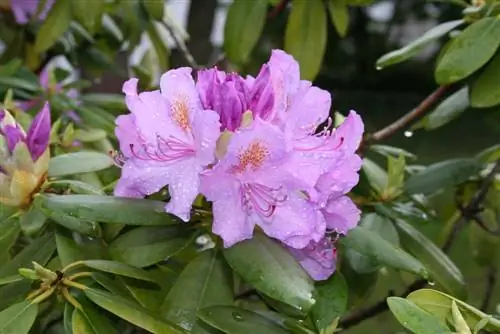
- widely distributed family of species with over 1,000 species
- Growth height of dwarf rhododendron approx. 50 to 80 centimeters
- Magnificent, large-sized goblet flowers
- Variety of flower colors from white to shades of yellow to red and reddish brown
- Large, long-oval leaves with a dark green, mostly waxy-looking surface
- particularly good for settling on slightly acidic soils, e.g. moorland
- Original forms partly strongly scented (also leaves)
- Characteristic color of the new shoots: copper-colored to bluish (depending on the species)
Grasses
Lastly, ornamental grasses offer a good opportunity to selectively break up the comparatively uniform level and appearance of the heather planting. Grasses can provide a striking but not dominating counterpart to the generally bushy, flat growth habit of heather plants.
Sweet grasses (Poaceae)
- Extremely diverse plant family with over 12,000 species
- Very wide distribution area with adaptations to a wide variety of locations and climatic conditions
- Available as both annual and hardy
- Growth heights of around 30 centimeters to over a meter possible for heather-suitable variants
- Mostly upright growing with long, straight stalks
- Best-known representative: Bamboo (due to its dominant appearance but less suitable for heather gardens)
Sedges (Cyperaceae)
- High species diversity up to
- Very persistent plants
- Prefer moist to wet soils
- Evergreen
- Most common genus: Carex
- Mostly distinctive fruit cluster as a more or less compact panicle or ear
Bulrushes (Juncaceae)
- Small family with only around 400 species
- Less conspicuous appearance than sweet grasses or sedges
- Growth heights around 1.00 to 1.50 meters
- Mostly very upright growth without prominent fruit cluster
- Preferred in temperate to cool climates
- Prefers moist locations, therefore can be used for moor heath, for example
- Especially found in the home garden as the common rush (Juncus) or marbel (Luzula)
Cattail family (Typhaceae)
- Only genus Typha with only around 10 species
- Require fresh water, therefore can only be used when combining a heather garden with a pond
- Very easy to grow
- Distinctive fruit clusters as clearly recognizable pistons at the end of the stable, usually tube-like thickened stalk
- Growth heights up to 2 meters, so only choose low-growing species
Tip:
Don't forget to include suitable elements in your heath planning alongside other companion plants. Both solitary stones and dead wood such as roots can loosen up and enrich the design.

